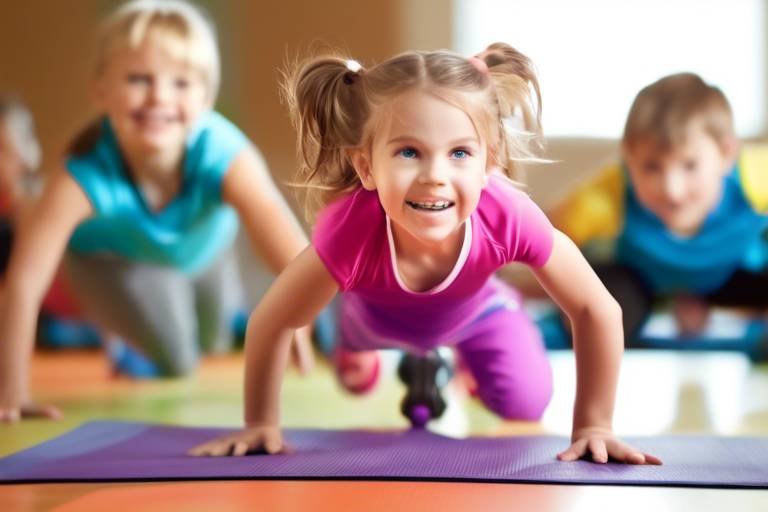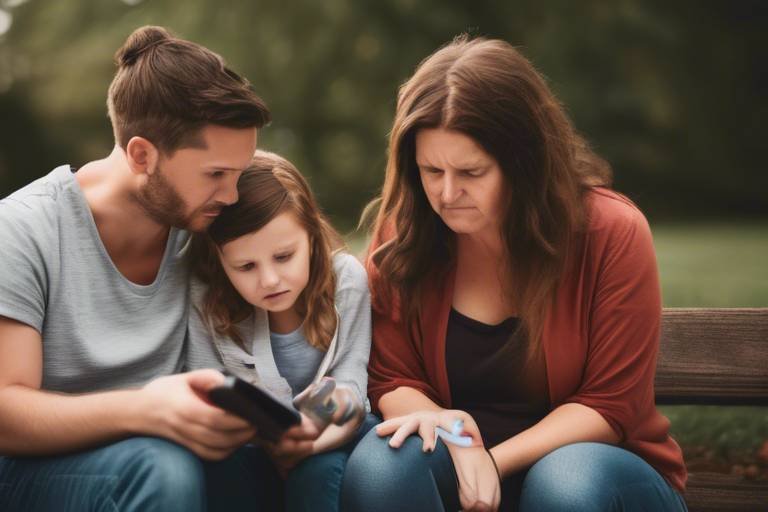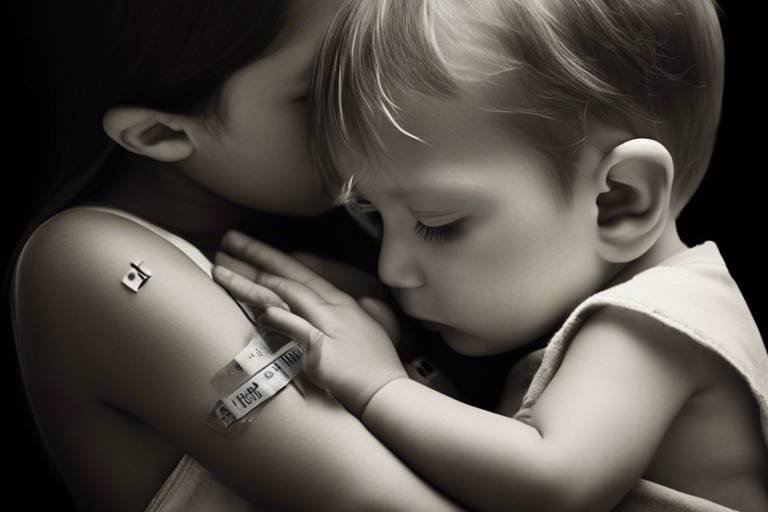Child Safety: How to Keep Kids Safe Near Water
When it comes to ensuring the safety of our little ones around water, we can't afford to be complacent. Water is a beautiful yet unpredictable element that can quickly turn from a place of fun to a scene of danger. Whether it's a swimming pool, a serene lake, or the vast ocean, understanding how to keep children safe is paramount. This article dives into essential strategies and precautions you can take to protect your kids while they enjoy water activities. From supervision to education, let’s explore how we can make water play a safe and enjoyable experience for everyone involved.
Before we can effectively protect our children, we must first understand the potential dangers lurking in various water environments. Every body of water presents its own unique set of hazards. For instance, swimming pools can have deep ends that pose drowning risks, while lakes may have unpredictable currents and hidden obstacles beneath the surface. It's crucial to identify these hazards and educate your children about them. Here are some common water hazards to be aware of:
- Strong Currents: Rivers and oceans can have currents that pull swimmers away from safety.
- Depth Changes: Sudden changes in depth can catch children off guard, leading to accidents.
- Hidden Obstacles: Rocks, branches, or even debris can create dangerous situations in natural water bodies.
By being aware of these risks, parents can better prepare their children to navigate water safely.
One of the most effective ways to prevent accidents is through vigilant supervision. It’s not enough to just be nearby; active monitoring is essential. When children are playing or swimming, having a watchful eye can mean the difference between a fun day and a tragic incident. Here are some best practices for effective supervision:
Assigning specific individuals as water watchers can greatly enhance safety. Designated water watchers are responsible adults who focus solely on supervising children during water activities. This means they should avoid distractions such as phones or conversations. Think of them as lifeguards for your family, ensuring that everyone is safe and sound.
To maintain vigilance, consider establishing a rotation system for water watchers. This way, everyone gets a turn to relax while still ensuring that children are supervised. A simple schedule can help keep track of who is watching at what time. For example:
| Time | Water Watcher |
|---|---|
| 10:00 AM - 11:00 AM | Parent A |
| 11:00 AM - 12:00 PM | Parent B |
| 12:00 PM - 1:00 PM | Parent C |
This rotation ensures continuous supervision without distractions, allowing everyone to enjoy the day safely.
Clear communication of safety rules is vital for both children and adults. Everyone involved should understand the pool rules and water safety guidelines. Take time to sit down with your kids and explain the dos and don’ts of being near water. For instance, make sure they know:
- Never swim alone.
- Always ask permission before entering the water.
- Stay within designated swimming areas.
By instilling these rules early, you can help your children develop a healthy respect for water and its dangers.
Teaching children to swim is an essential safety measure that cannot be overstated. Enrolling kids in swimming lessons not only builds their confidence in the water but also equips them with vital skills that can save lives. Swimming lessons provide structured learning environments where children can practice under the guidance of trained instructors. Plus, it’s a fun way for kids to socialize and stay active. So why not invest in their safety and enjoyment? After all, a child who knows how to swim is a child who can enjoy water activities with greater confidence.
Being prepared for emergencies can save lives. Accidents can happen in the blink of an eye, and having a plan in place can make all the difference. Here are some essential items to keep on hand when near water:
- First Aid Kit: Always have a well-stocked first aid kit nearby.
- Rescue Equipment: Items like life rings or floatation devices should be easily accessible.
- Emergency Phone Numbers: Keep a list of emergency contacts handy, including local emergency services.
Knowledge of CPR and first aid is critical for caregivers. Training adults to respond effectively in emergencies involving children and water can be lifesaving. Consider taking a CPR course to ensure you are prepared for any situation. Remember, the more prepared you are, the more confident you will feel when your children are near water.
Keeping emergency contact information readily available is vital when enjoying water activities. Make sure to have phone numbers and resources easily accessible. Consider creating a small waterproof card that includes:
- Your emergency contacts.
- Local emergency services numbers.
- Poison control hotline.
By having this information on hand, you can act quickly in case of an emergency, ensuring your child's safety is always a priority.
Q: What is the best age to start swimming lessons for my child?
A: Most experts recommend starting swimming lessons around age 4, but it can vary based on the child's comfort level in water.
Q: How can I ensure my child is safe at the beach?
A: Always supervise your child closely, educate them about rip currents, and ensure they stay within designated swimming areas.
Q: What should I do if my child is missing near water?
A: Immediately alert lifeguards, search the immediate area, and call emergency services if you cannot find them quickly.

Understanding Water Hazards
When it comes to keeping our little ones safe around water, understanding the potential hazards is absolutely essential. Water can be as inviting as a cool breeze on a hot summer day, but lurking beneath the surface are dangers that can turn a fun outing into a nightmare. From swimming pools to lakes and beaches, each water environment presents its own unique set of challenges. For instance, currents in lakes can be deceptive, often appearing gentle while actually being strong enough to sweep away even the best swimmers. Similarly, the depth of a pool or a natural body of water can vary significantly, posing risks to children who may not be aware of their limits.
Moreover, it's not just the visible hazards that we need to worry about. Hidden obstacles, such as rocks, submerged logs, or even sharp objects, can be dangerous for kids who are splashing around without a care in the world. Imagine a child diving into what seems like a safe area only to encounter a hidden danger beneath the surface. This is why it's crucial for parents and caregivers to conduct a thorough inspection of the water environment before allowing children to play. They should be on the lookout for:
- Strong currents that can pull swimmers away from safety.
- Sudden drops in depth that may catch children off guard.
- Obstructions just below the water's surface that are not easily visible.
- Water temperature variations that can lead to hypothermia in colder waters.
Additionally, it's important to educate children about these hazards. They should know what to look for and how to respond if they find themselves in a risky situation. Teaching them to recognize the signs of dangerous currents or to avoid diving in areas where they can't see the bottom can make a significant difference. Just as we teach kids to look both ways before crossing the street, we need to instill a healthy respect for the water and its potential dangers.
In summary, understanding water hazards is not just about recognizing the obvious dangers; it's about fostering a culture of safety and awareness. By being proactive and educating our children, we can create a safer environment that allows them to enjoy water activities without unnecessary risks. Remember, a little knowledge can go a long way in preventing accidents and ensuring that our kids have a fun and safe experience around water.

Supervision Strategies
When it comes to keeping our little ones safe around water, effective supervision is not just important; it's absolutely essential. Imagine a world where every splash and giggle is accompanied by a watchful eye, ensuring that every child is safe and sound. The truth is, accidents can happen in the blink of an eye, which is why as parents and caregivers, we need to be proactive and vigilant. So, how can we enhance our supervision strategies? Let's dive into some practical tips!
First and foremost, it's crucial to establish a designated water watcher. This is not just a fancy term; it means assigning a responsible adult whose sole job is to keep an eye on the kids while they are playing or swimming. Think of this person as the lifeguard of the family or group. They should be free of distractions, such as their phone or conversations that take their attention away from the water. This focused attention can significantly reduce the risk of accidents.
Now, how do we ensure that our designated watcher doesn't get overwhelmed or distracted? One effective method is to create a watcher rotation. This involves setting up a schedule where different adults take turns being the water watcher. For example, if you’re at a family gathering, you might establish a rotation every 30 minutes. This not only keeps everyone engaged but also prevents fatigue and ensures that there’s always someone alert and ready to respond if needed. You can even create a simple
| Time Slot | Water Watcher |
|---|---|
| 1:00 PM - 1:30 PM | Mom |
| 1:30 PM - 2:00 PM | Dad |
| 2:00 PM - 2:30 PM | Aunt Sue |
| 2:30 PM - 3:00 PM | Uncle Joe |
In addition to having a watcher rotation, it’s equally important to communicate safety rules effectively. Before heading to the pool or beach, gather the kids and adults alike to go over the rules. Make it a fun and engaging experience! Explain why certain rules exist, such as no running near the water or always asking for permission before going into deeper areas. This helps everyone understand the importance of safety and encourages them to look out for one another.
Lastly, it’s vital to remember that supervision is not just about being present; it’s about being actively engaged. This means that while you may be enjoying a conversation with friends, your eyes should still be on the kids. Use a technique called the "360-degree scan," where you periodically check all areas of the water where children are playing. This simple act can be the difference between a fun day and a tragic incident.
In summary, the key to effective supervision near water lies in designating specific watchers, rotating responsibilities, communicating rules clearly, and staying actively engaged. By implementing these strategies, we can create a safer environment for our children, allowing them to enjoy their time in the water while giving us peace of mind.
- What is the most important rule for supervising children near water?
Always have a designated adult who is focused solely on watching the children. - How can I ensure that the water watchers stay alert?
Establish a rotation system and encourage breaks to keep everyone fresh and attentive. - What should I do if I see a child in trouble?
Immediately call for help and attempt to assist the child if it is safe to do so.

Designated Water Watchers
When it comes to ensuring the safety of our children around water, the concept of is not just a good idea; it's a vital strategy. Imagine a bustling pool party or a serene day at the beach. The laughter of children splashing around can easily drown out the sounds of caution. This is why having specific adults assigned as water watchers is crucial. These individuals take on the responsibility of keeping a vigilant eye on the kids, free from distractions like chatting with friends or scrolling through their phones.
Why is this important? Well, children can get into trouble in the blink of an eye. A momentary lapse in attention can lead to accidents that could have been easily prevented. By designating water watchers, we create a safety net. These individuals should be adults who are comfortable in the water and aware of the potential dangers that can arise. They need to be committed to the task at hand, focusing solely on supervising the children. This means no multitasking—no cooking, no texting, and definitely no diving into a riveting conversation.
To make this system even more effective, consider establishing a watcher rotation. This way, everyone gets a chance to enjoy the water while still ensuring that there’s always a dedicated adult watching over the kids. For instance, if you’re at a family gathering, you can set a timer for 20-30 minutes, rotating the responsibility among adults. This not only keeps the children safe but also allows each adult a break to relax and enjoy the festivities without the constant worry of supervision.
Furthermore, communication is key. Before diving into the fun, gather everyone together and discuss the safety rules. Make sure that both the designated watchers and the children understand the importance of these guidelines. For example, explain what to do if someone is in trouble or how to recognize when a child is getting too tired or too far from the edge. When everyone is on the same page, the atmosphere becomes safer and more enjoyable for all.
In conclusion, designating water watchers is a simple yet effective way to enhance child safety near water. By assigning specific adults to this important task, creating a rotation, and ensuring clear communication of safety rules, we can significantly reduce the risks associated with water activities. So, the next time you’re planning a day by the pool or at the beach, remember that a little organization can go a long way in keeping our children safe.

Creating a Watcher Rotation
Establishing a watcher rotation is not just a smart idea; it’s a game changer when it comes to ensuring the safety of children around water. Imagine a busy pool party or a day at the beach where excitement is in the air, laughter fills the space, and the last thing you want is for anyone to lose focus on the kids splashing around. By setting up a rotation system for designated water watchers, you can maintain a constant, vigilant eye on the little ones while also allowing adults to enjoy the day without the weight of constant supervision on their shoulders.
The first step in creating a watcher rotation is to gather all the adults who will be present. This could include parents, relatives, friends, or even responsible older siblings. Once everyone is on board, it’s essential to establish a clear schedule. You might consider using a simple time slot system where each adult takes turns watching the children for a specific duration—say, 20 to 30 minutes—before passing the responsibility to the next person. This way, everyone gets a chance to relax while still ensuring that the kids are under constant supervision.
To make this process seamless, you could create a
| Time Slot | Water Watcher |
|---|---|
| 1:00 PM - 1:30 PM | John |
| 1:30 PM - 2:00 PM | Maria |
| 2:00 PM - 2:30 PM | David |
| 2:30 PM - 3:00 PM | Lisa |
This table serves as a visual guide, making it easy for everyone to know when they are responsible for watching the kids. Remember, the key to a successful rotation is communication. Before the fun begins, gather everyone together to discuss the importance of this system and ensure that everyone understands their role. Encourage the watchers to stay alert and minimize distractions, such as phone use or deep conversations with other adults.
Another vital aspect of the watcher rotation is to have a designated backup in case someone needs to step away unexpectedly. This could be a close friend or another adult who is willing to jump in when needed. By having a backup, you can ensure that there is always someone keeping an eye on the children, no matter what happens. You might even consider having a whistle or some other signal to alert the group if immediate assistance is needed or if someone feels overwhelmed.
In conclusion, implementing a watcher rotation is a simple yet effective way to enhance child safety near water. It allows everyone to enjoy their time while knowing that the kids are being watched closely. So, next time you’re planning a fun day by the pool or at the beach, take a moment to create a rotation plan. It’s a small effort that can lead to big peace of mind!

Communicating Safety Rules
When it comes to keeping our little ones safe around water, effective communication of safety rules is absolutely essential. Kids are naturally curious and often don’t fully grasp the potential dangers lurking in pools, lakes, or beaches. Therefore, it’s crucial to ensure that both children and adults understand and respect the established safety guidelines. But how do we do this effectively? First and foremost, it's important to use simple and clear language that resonates with children. Instead of using complex terms, try to break down the rules into bite-sized pieces that are easy to remember.
For instance, you might say, “Always swim with an adult” or “Never run near the pool.” These straightforward phrases are not only easier for kids to comprehend but also make it more likely that they will remember them. Additionally, consider incorporating fun and engaging methods to communicate these rules. You could create colorful posters with illustrations that depict the rules visually, or even turn the rules into a catchy song or rhyme. Kids are more likely to remember information that is presented in a fun and playful manner!
Moreover, it's vital to involve children in discussions about safety. Ask them questions like, “What do you think is important to remember when we’re at the pool?” This not only empowers them but also reinforces their understanding of the rules. When children feel like they are part of the conversation, they are more likely to take the safety rules seriously. Role-playing scenarios can also be a great way to practice these rules in a safe environment. For example, you could simulate a situation where a child needs to ask an adult for help, teaching them how to do so in a calm and confident manner.
In addition to communicating the rules to children, it’s equally important to ensure that all adults present are well-informed. This includes parents, caregivers, and even friends who may be supervising during outings. A quick family meeting before heading to the water can be a great way to review the rules together. Consider using a checklist to ensure that everyone is on the same page:
| Safety Rule | Who is Responsible? |
|---|---|
| Always swim with an adult | Children |
| No running near the pool | All adults |
| Wear life jackets when necessary | Adults |
| Know the emergency plan | All |
By establishing clear rules and ensuring that everyone understands their role in maintaining safety, we can create a much safer environment for our children. Remember, communication is not just about telling; it’s about listening and engaging. Encourage open dialogue about water safety, and don’t hesitate to revisit these discussions regularly. The more we talk about it, the more second nature these safety measures will become for everyone involved.
- What age should children start swimming lessons? Most experts recommend starting swimming lessons as early as age 1, but it can vary based on the child's comfort level.
- How can I ensure my child understands water safety rules? Use simple language, engage them in discussions, and practice through role-playing scenarios.
- What should I do if I see a child in trouble in the water? Immediately call for help, and if trained, perform CPR until professional assistance arrives.

Swimming Lessons and Training
When it comes to keeping our little ones safe around water, one of the most effective strategies is enrolling them in swimming lessons. Think of swimming lessons as the life jacket for their confidence and safety in the water. Not only do these classes teach essential skills, but they also provide children with the knowledge needed to navigate various water environments. Imagine your child splashing around in a pool, feeling like a little fish, completely at ease with their surroundings. That’s the kind of comfort and security swimming lessons can provide!
Swimming lessons are not just about learning how to float or perform a backstroke; they are about empowering children with the skills to react appropriately in different water situations. For instance, children learn how to recognize potential dangers, such as strong currents in lakes or the deep end of a pool. They also gain an understanding of how to help themselves and others in emergencies, which is invaluable. It's like giving them a superhero cape, but instead of flying, they learn to swim!
Moreover, swimming lessons can significantly reduce the risk of drowning. According to the Centers for Disease Control and Prevention (CDC), formal swimming lessons can decrease the risk of drowning by up to 88% in children aged 1 to 4. That’s a staggering statistic! This is why many parents opt to start lessons as early as possible, often around the age of 4, when children are typically developmentally ready to learn.
So, what can parents expect from swimming lessons? Generally, they include:
- Water Familiarization: Children get comfortable in the water, learning to float and submerge themselves.
- Basic Swimming Techniques: Kids learn strokes, breathing techniques, and how to stay afloat.
- Safety Skills: Lessons often cover essential safety tips, such as how to enter and exit the water safely.
- Emergency Response: Kids are taught how to react if they or someone else is in trouble.
Additionally, swimming lessons are a fantastic way for kids to socialize and build friendships. They get to meet peers with similar interests, all while learning a life-saving skill together. The camaraderie formed in these classes can lead to a supportive environment where children feel encouraged to challenge themselves and improve. It’s like a mini-community of young swimmers cheering each other on!
In conclusion, investing in swimming lessons for your child is one of the best decisions you can make for their safety and confidence around water. It’s not just about keeping them safe; it’s about giving them the tools they need to enjoy water activities responsibly. So, why wait? Dive into the world of swimming lessons today!
1. At what age should I start my child in swimming lessons?
Most experts recommend starting swimming lessons around the age of 4, although some programs offer classes for younger children. It's essential to assess your child's readiness and comfort level in the water.
2. How long do swimming lessons typically last?
Swimming lessons usually last between 30 minutes to an hour, depending on the age group and the program. Consistency is key, so regular lessons can help reinforce skills.
3. Are swimming lessons guaranteed to prevent drowning?
While swimming lessons significantly reduce the risk of drowning, they do not guarantee complete safety. Continuous supervision and adherence to safety guidelines are equally important.
4. What should my child wear to swimming lessons?
Children should wear a comfortable swimsuit, and it’s often recommended to use swim goggles for better visibility underwater. Don’t forget a towel for after the lesson!
5. Can I attend swimming lessons with my child?
Many programs allow parents to observe or even participate in lessons, especially for younger children. Check with your local swimming school for their policy.

Emergency Preparedness
When it comes to keeping our children safe near water, is not just a precaution; it’s a necessity. Imagine you're at a sunny beach, laughter filling the air, when suddenly, an unexpected wave crashes in. Will you be ready? The truth is, being prepared for emergencies can make all the difference between a close call and a tragedy. It's essential to have a plan and the right tools at hand to ensure that you can respond swiftly and effectively in any water-related incident.
First and foremost, consider assembling an emergency kit specifically for water activities. This kit should include essential items that can help in a crisis. Here’s a quick rundown of what to include:
- First Aid Kit: Make sure it’s stocked with band-aids, antiseptics, and any necessary medications.
- Rescue Equipment: Items like a flotation device, whistle, or rescue ring can be lifesavers.
- CPR Instructions: Having a clear guide can help in high-stress situations.
- Emergency Contact List: Keep a list of important phone numbers, including local emergency services.
Additionally, it’s crucial to have a plan in place for what to do in case of an emergency. This means not only knowing how to perform CPR but also understanding the signs of distress in children. For instance, children may not always yell for help; sometimes, they might just struggle silently. Recognizing these signs can be the key to preventing a disaster.
Moreover, ensure that all adults and caregivers involved in supervising children near water are trained in CPR and first aid. This training provides them with the skills needed to respond effectively in emergencies. Many local organizations offer courses that are not only informative but also practical, giving participants hands-on experience in life-saving techniques. Knowing that someone nearby is trained can give you peace of mind while your children are playing.
Another important aspect of emergency preparedness is keeping emergency contact information readily accessible. This should include phone numbers for local emergency services, poison control, and family members. Consider using a waterproof pouch or a designated spot in your bag to keep this information safe and easy to reach. In a moment of panic, having quick access to these contacts can save precious time.
Finally, it’s vital to communicate your emergency plan to everyone involved in supervising the children. Make sure they know where the emergency kit is located, the signs of distress to watch for, and how to contact emergency services. Having a clear, shared understanding of the plan can help ensure that everyone reacts swiftly and effectively in a crisis.
Q: What should I do if I see a child struggling in the water?
A: Immediately call for help, and if you are trained, you can attempt a rescue using a flotation device or reach for the child with a long object, but never put yourself in danger.
Q: How can I ensure my child is safe while swimming?
A: Always supervise your child, enroll them in swimming lessons, and make sure they wear appropriate flotation devices if they are not strong swimmers.
Q: What items should be in my emergency kit?
A: Your kit should include a first aid kit, rescue equipment, CPR instructions, and an emergency contact list.

CPR and First Aid Training
When it comes to child safety around water, knowing how to perform CPR (Cardiopulmonary Resuscitation) and basic first aid is not just a good idea—it’s a life-saving skill. Imagine a scenario where a child accidentally slips underwater and struggles to breathe. In those precious moments, having a caregiver who knows CPR can make all the difference. This training equips individuals with the knowledge to respond effectively in emergencies, potentially preventing tragic outcomes.
CPR is a technique that combines chest compressions and rescue breaths to help keep blood flowing to the brain and other vital organs until professional help arrives. It’s essential for anyone supervising children near water to be trained in this skill. Many organizations, such as the American Red Cross and the American Heart Association, offer courses specifically designed for parents and caregivers. These courses not only teach the mechanics of CPR but also provide valuable insights into recognizing the signs of drowning and how to respond promptly.
First aid training complements CPR by preparing caregivers to handle various injuries that may occur in or around water, such as cuts, scrapes, or even more severe situations like hypothermia. Knowing how to treat these injuries can alleviate panic and ensure that the child receives the appropriate care until help arrives. Some key components of first aid training include:
- Identifying and treating common injuries
- Understanding the signs of shock
- Managing allergic reactions
- Recognizing the symptoms of drowning
Moreover, it’s important for caregivers to stay updated on their certifications. Many organizations recommend renewing CPR and first aid certifications every two years to ensure that the skills remain sharp and relevant. This commitment to ongoing education not only enhances safety but also instills confidence in caregivers, allowing them to act decisively in emergencies.
In addition to formal training, caregivers should create a first aid kit specifically tailored for water-related incidents. This kit should include essential items such as:
| Item | Purpose |
|---|---|
| Adhesive Bandages | For minor cuts and scrapes |
| Antiseptic Wipes | To clean wounds |
| Gauze and Tape | For larger wounds |
| CPR Face Shield | To perform CPR safely |
| Emergency Contact List | To quickly reach help |
Having these items readily available can significantly improve response times in emergencies. Remember, the goal is not just to react but to be prepared. This proactive approach to safety can give parents and caregivers peace of mind when their children are enjoying water activities.
In summary, are essential components of child safety near water. By being prepared, caregivers can not only prevent accidents but also respond effectively should an incident occur. This training empowers them to act quickly and confidently, ultimately safeguarding the well-being of the children in their care.
Q: How often should I renew my CPR and first aid certifications?
A: It is recommended to renew your CPR and first aid certifications every two years to ensure your skills are current.
Q: Where can I find CPR and first aid training courses?
A: You can find courses through organizations such as the American Red Cross, local community centers, or hospitals.
Q: What should I include in my first aid kit for water activities?
A: Your first aid kit should include adhesive bandages, antiseptic wipes, gauze, a CPR face shield, and an emergency contact list.

Emergency Contact Information
When it comes to child safety near water, being prepared for emergencies is a non-negotiable aspect of ensuring their well-being. One of the most critical components of this preparedness is having readily accessible. Imagine a scenario where a child has an accident in the water; the seconds it takes to retrieve a phone or search for contact details could be the difference between a swift response and a delayed reaction. Therefore, it’s essential to have a well-organized system in place.
First and foremost, you should create a designated emergency contact list. This list should include:
- Local emergency services (911 in the U.S.)
- Poison Control Center
- Nearest hospital or urgent care facility
- Family members or friends who can assist in emergencies
- Any relevant medical professionals, such as pediatricians
It’s a good idea to keep this list in a visible place, such as on the refrigerator or inside a waterproof pouch that you can take with you to the pool or beach. In addition to the physical list, consider saving these contacts in your phone. Make sure the contacts are labeled clearly so anyone can find them quickly. You could even create a group contact for emergencies, so you can reach multiple people with a single message.
Moreover, it can be incredibly helpful to have a first aid kit nearby that includes essential items such as band-aids, antiseptic wipes, and a breathing mask for CPR. But remember, having supplies isn't enough; knowing how to use them is crucial. Make it a family activity to familiarize everyone with the kit and its contents. You can even turn it into a fun quiz to see who remembers what goes where!
Lastly, don’t forget to update your emergency contact information regularly. Life changes, and so do your contacts. A family member might move, or a friend may change their phone number. Keeping this information current ensures that you won’t be left scrambling in a crisis. Consider reviewing your emergency contacts every few months, perhaps during a family meeting or when you have a gathering. This way, everyone is on the same page, and you can all feel a little more secure when enjoying time near the water.
In conclusion, having emergency contact information readily available and organized is not just a precaution; it’s a lifeline in critical situations. By taking these steps, you’re not only safeguarding your children but also empowering yourself and others to act swiftly and effectively when it matters most.
Q: What should I include in my emergency contact list?
A: Your emergency contact list should include local emergency services, poison control, nearby hospitals, family members, and any relevant medical professionals.
Q: Where is the best place to keep the emergency contact information?
A: Keep it in a visible location, such as on the refrigerator, and also save it in your phone for quick access.
Q: How often should I update my emergency contacts?
A: Review and update your emergency contacts every few months or during family gatherings to ensure accuracy.
Frequently Asked Questions
- What are the main water hazards I should be aware of?
When it comes to keeping kids safe around water, it's essential to recognize potential hazards. Common dangers include strong currents in lakes or rivers, deep areas in pools, and hidden obstacles like rocks or sudden drop-offs. Always be vigilant and assess the environment before allowing children to play.
- How can I effectively supervise my children near water?
Effective supervision is all about staying focused and present. Designate a specific adult as the "water watcher," ensuring they are not distracted by phones or conversations. It’s also helpful to establish a rotation of watchers to maintain vigilance during playtime. Remember, eyes should always be on the kids!
- Why are swimming lessons important for children?
Swimming lessons are crucial because they equip children with the skills and confidence to navigate water safely. Learning to swim can significantly reduce the risk of drowning and helps kids feel more comfortable in various water environments. Plus, it’s a fun way for them to stay active!
- What should I do in case of a water emergency?
Being prepared for a water emergency can make all the difference. Always keep essential items like a first aid kit, flotation devices, and a phone nearby. Knowing CPR and first aid is vital, as it allows you to respond quickly and effectively. Make sure to have emergency contact information readily accessible as well.
- How can I communicate safety rules to my children?
Clear communication is key! Sit down with your kids and explain the safety rules in simple terms. Use engaging examples and role-play scenarios to make the rules memorable. Consistently remind them of these rules whenever you’re near water, reinforcing their importance to ensure they understand and remember.



















